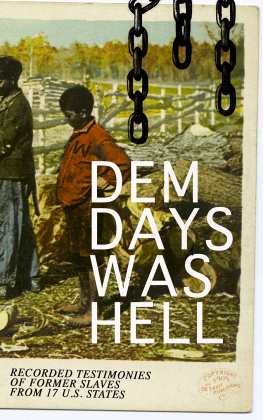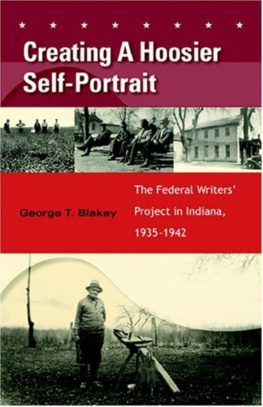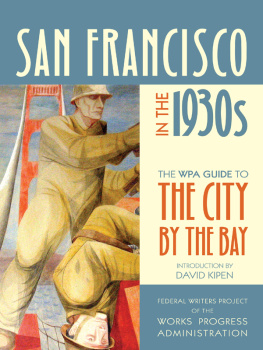INDIANA
A Guide to the Hoosier State

Published in 2014 by Trinity University Press
San Antonio, Texas 78212
www.tupress.org
This book was first published as part of the Works Progress Administrations Federal Writers Project, a United States federal government project to fund written work and support writers during the Great Depression. It has been published in various editions, but this edition replicates the original. Trinity University Press is proud to make these books available through the WPA Guides to America Digital Library.
978-1-59534-212-6 ebook

The United States is a young Nation approaching maturity. It has been a melting pot for many nationalities, and out of that melting pot has come an alloy of Old World culture tempered by New World conditions.
Now our Nation, in the consciousness of its approaching maturity, is beginning to become interested in its own cultural heritages. During the feverish period of economic, scientific, and social expansion there was little time in which Americans could look backward. They were more interested in pushing ahead than in looking back over the trail they had taken. Indeed there seemed to be a fear of looking backward lest they stumble in the headlong rush. That is a characteristic of youth.
But in late years the people of the United States have come to the realization that there has been slowly developing a heritage peculiar to themselves. Steps have been taken to probe into the sources of this heritage, and to seek to discover its component elements. The American Guide Book Series is such an attempt.
This study of the past in the light of the future is no sign of weakness. It does not mean that progress has stopped nor that our Nation has begun too early to dwell in its past. Neither is it a resting on old laurels. Rather it is a quickening of our national consciousness.
Indiana State Teachers College and other agencies of educational leadership that have sponsored the Guide Series take pride in contributing to the gathering together of a great treasure trove of historical and cultural information. The story of America is an exciting history of dynamic progress, and much of it is to be found in the individual stories of the States such as this one.
Every Hoosier believes that Indiana has made a great contribution to culture in the United States, and that the story of this peculiarly distinctive State is worthy of the closest scrutiny by all Americans.
RALPH N. TIREY
President
Indiana State Teachers College

Indiana: A Guide to the Hoosier State, like its companion volumes in the American Guide Series, goes beyond the usual limits of a guidebook and portrays Indiana in terms of its people and their background, its points of interest, natural setting and resources, and its social and economic development.
Differences in people, in topography, and in economic factors have made the compilation of this book a difficult task. Information was not always available in its entirety. Authorities often differed on selection and interpretation of facts, and at many points honest and justifiable divergence of opinion occurred. The editors, nevertheless, believe they have achieved a maximum of accuracy, but if here and there they have fallen short of this objective, they will appreciate learning of it for subsequent correction.
Hundreds of Hoosiers aided generously in compiling this book. To list all of them would require pages, but to each go the thanks of the staff. Particularly helpful were: Dr. Christopher B. Coleman, Director of both the Indiana Historical Bureau and the Indiana State Library; the entire staff of the State Library; various faculty members of Indiana State Teachers College, Indiana University, Purdue University, and the University of Notre Dame; Dr. Otho Winger, president of Manchester College; Dr. Sanford C. Yoder, president of Goshen College; Wilbur Peat, director of the John Herron Art Institute; Dr. Charles F. Voegelin of the Department of Anthropology, DePauw University, and Dr. Erminie W. Voegelin of DePauw University; officials of the Department of Conservation and the State Highway Commission; the staff of the State Planning Board of Indiana; the late Reverend James Matthew Gregoire (1880-1938), Vincennes; Mrs. Bess V. Ehrmann, Rockport; the late Clarence P. Wolfe, New Harmony; Judge Hal C. Phelps, Peru; Dr. William A. Huggard and Dr. Andrew W. Crandall of the faculty of DePauw University; Dr. Stith Thompson of the faculty of Indiana University; Charles E. Baurle, Indianapolis; Lee Burns, Indianapolis; Ross F. Lockridge, director of the New Harmony Memorial Commission and at one time State Supervisor of the Indiana Writers Project; and Thomas R. Johnston of Purdue University. Thanks are due to Harcourt, Brace & Company for permission to quote from Smoke and Steel by Carl Sandburg. Acknowledgment is also due to national, regional, and State officials of the Work Projects Administration, who have without exception been most co-operative.
Although this book has been a joint responsibility involving many workers, especial mention should be made of Rebecca E. Pitts, Charlotte Davis, Howard G. Underwood, Norbert W. Meyers, W. Clay Stearley, William A. Myers, John F. Kingsbury, Roger A. Hurst, former Assistant State Supervisor; and Dickson J. Preston and Ray Thurman, Assistant State Supervisors. Final work on the guide was done with the editorial co-operation of Stella Bloch Hanau of the WPA Writers Program.
GORDON F. BRIGGS
State Supervisor

Contents

Illustrations

Maps

Railroads: Algiers, Winslow & Western; Baltimore & Ohio; Chicago & Eastern Illinois; Chesapeake and Ohio; Cleveland, Cincinnati, Chicago & St. Louis; Chicago, Indianapolis & Louisville; Chicago, Milwaukee, St. Paul & Pacific; Erie; Ferdinand; Grand Trunk; Illinois Central; Indiana Harbor Belt; Indianapolis Belt; Joliet, Elgin & Eastern; Louisville & Nashville; Louisville, New Albany & Corydon; Michigan Central; New Jersey, Indiana & Illinois; New York Central; Pennsylvania; Pere Marquette; Southern; Toledo, Peoria & Western; Wabash.
Bus Lines: Major east-west transcontinental bus lines crossing Indiana include Greyhound, Swallow Coach Lines, National Trailways, and the All American Bus Lines. A network of intrastate lines connects almost all cities and towns in the State.
Next page





